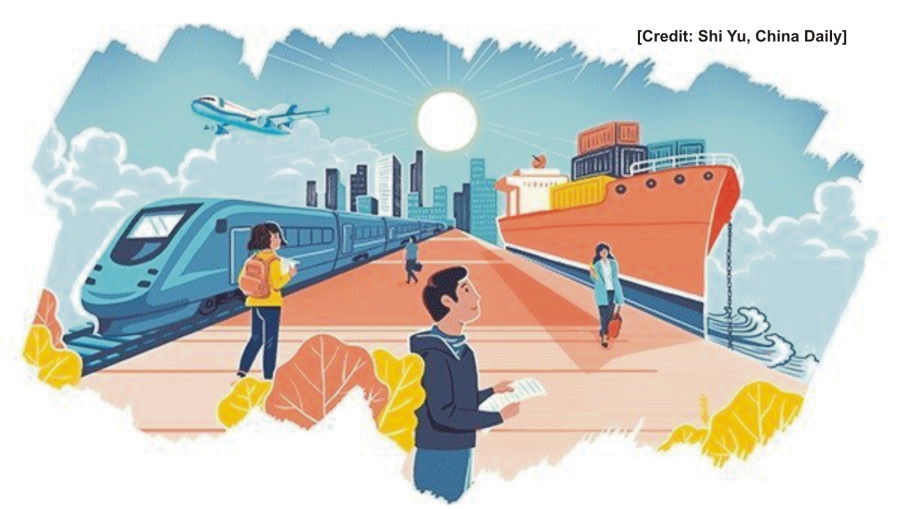The geographical location of a country determines its role in the world politics. It denotes that critically how beneficial or non-beneficial one country is to the others in terms of the social, economic and political aspects. Strategically, Pakistan is located at a very significant geo-strategic place on the globe. It is situated at the juncture of energy proficient to the energy deficient countries. The geo-strategic importance of Pakistan is evident from the fact that it is bordered by the emerging economic giants of the world i.e. India and China, and by the countries rich in abundant natural resources i.e. Afghanistan and Iran. Historically, it is evident that the very concept of a corridor has been a cause of development in different parts of the world. In the post-1945-time, European Economic Community was formed in 1957, which was later incorporated and renamed as the European Community (EC) in November 1993 and then reformed to the European Union (EU) in 2009, based on the pillars of free movement of people, goods, services and capital. The idea of establishment of the Exclusive Economic Zones (EEZs) encompassing Cambodia, Laos, Vietnam and Myanmar under the Greater Mekong Sub-Region Economic Cooperation Programme is also parallel to the concept of establishment of economic corridor for promoting trade and people-to-people contact by interaction. Economic corridors have emerged in the recent years as an important tool of regional cooperation, integration and development in a globalized world under reciprocity. Following the experience of economic integration at the regional level through a network of transnational economic corridors in the Greater Mekong Sub-region, similar initiatives have now been stimulated in different parts of Asia to speed up economic growth by linking backward regions with more established industrial centres and to improve access to markets through the incorporation of trans-border production networks. The idea of building mega projects through Pakistan is not novel. In the late 1990s an earlier American proposed project under consideration, in which the oil and gas would have been transported by a pipeline from the oil-rich Central Asian Republics (CARs) through Afghanistan and Baluchistan Province of Pakistan was dropped due to the security concerns. It demonstrates the capacity of Baluchistan to play a pivotal role in the overall economy and the enhancement of the objectives of national interest of Pakistan. Keeping in mind the changing geo-strategic environment, Pakistan is looking forward to improve security of its largest province. Russia, which had a cooled relationship with Pakistan at one time in history, is now warming up and has shown keenness in the Corridor, besides building Karachi-Lahore gas pipeline. China as being the neighbour of South Asia has a special significance in enhancing the agenda of constructive engagements, which is now evident from the active involvement of Chinese leadership in South Asian region. President Xi visited South Asian countries and announced huge investment packages and trade enhancement programmes for mutual benefits and regional integration. China is going to build its leading role in Asia and beyond for economic and political cooperation through “One Belt One Road (OBOR)”initiative. The “One Belt One Road” plan integrates an area with a population of 4.4 billion people and a total economic volume of US $ 21 trillion, being 29 percent of the world’s total. OBOR project consists of two major components: first, the network of land-based ‘New Silk Road’; and secondly, the 21st Century Maritime Silk Road. The aim is to create a Silk Road Economic Belt (SREB) altogether through a huge network of transportation corridors, oil & gas pipelines, ports and fibre-optic cables spreading across the entire Eurasian landmass linking East Asia, Central Asia, South Asia, Middle East and parts of Europe. Chinese Premier Mr. Li Keqiang during his visit to Pakistan from 22 to 23 May 2013, wished for a China-Pakistan Economic Corridor (CPEC) in relation to connect Kashgar in China’s Xinjiang Uygur Autonomous Region with the Southwestern Gwadar Port of Pakistan. The strategic bonds between Pakistan and China have been on an upward trajectory with moved thrust on economic interaction after the initiation of CPEC project since 2013. Under CPEC, China would invest billions in Pakistan for the development of transportation infrastructure and energy projects. CPEC is a futuristic socio- political and economic object oriented dimension of Pakistan in the 21st century.
This multi-faceted project has opened new vistas of Pakistan’s rebalancing options from geo-politics to geo-economics. It comprises four pillars namely, the infrastructure, the energy requirements, workforce development and economic progress. CPEC project is not an economic and financial aid given to Pakistan but an investment for the next 15 to 30 years. This time-frame is significant for Pakistan as it is the period in which Pakistan by the utilization of its resources and manpower could bring Pakistan in line to the mainstream of global economies. It has been anticipated that if CPEC has been utilized properly, it would bounce the economy of Pakistan from three to four times. It is appropriate to mention here that CPEC is a long-term broader framework with multiple dimensional proposed projects, which would be accomplished in different phases through bilateral agreements approved by the two sides as a win-win equation. It might be possible to acquire a deeper understanding of the New Silk Road by looking at how CPEC develops and influences Pakistan and its neighboring countries. The major aim of the Corridor is to enhance the well-being of people throughout the country and to bring about long-term socio-economic prosperity and political stability. The Corridor emphasizes to facilitate multi-dimensional economic collaboration in finance, trade, energy and industry. The leadership of both countries has built an all-weather friendship and close political relationship over the previous years. (Courtesy: International Journal of Social Sciences, Humanities and Education)









